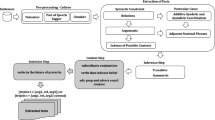Abstract
In this paper we suggest the logical-linguistic model that allows extracting required facts from English sentences. We consider the fact in the form of a triplet: Subject > Predicate > Object with the Predicate representing relations and the Object and Subject pointing out two entities. The logical-linguistic model is based on the use of the grammatical and semantic features of words in English sentences. Basic mathematical characteristic of our model is logical-algebraic equations of the finite predicates algebra. The model was successfully implemented in the system that extracts and identifies some facts from Web-content of a semi-structured and non-structured English text.
Access this chapter
Tax calculation will be finalised at checkout
Purchases are for personal use only
Similar content being viewed by others
References
Fader, S., Soderland, O.: Etzioni Identifying relations for open information extraction. In: Conference on Empirical Methods in Natural Language Processing. Edinburgh, Scotland, pp. 1535–1545 (2011)
Sint, R., Schaffert, S., Stroka, S., Ferstl, R.: Combining unstructured, fully structured and semi-structured information in semantic wikis. In: Proceedings of the 4th Semantic Wiki WorkShop (SemWiki) at the 6th European Semantic Web Conference, ESWC (2009)
Crestan, E., Pantel, P.: Web-scale knowledge extraction from semi-structured tables. In: WWW 2010 Proceedings of the 19th International Conference on World Wide Web, pp. 1081–1082 (2010)
Gatterbauer, W., Bohunsky, P., Herzog, M., Krupl, B., Pollak, B.: Towards domain-independent information extraction from web tables. In: Proceedings WWW-07, pp. 71–80. Banff, Canada (2007)
Wong, Y.W., Widdows, D., Lokovic, T., Nigam, K.: Scalable attribute-value extraction from semi-structured text. In: 2009 IEEE International Conference on Data Mining Workshops, pp. 302–307 (2009)
Phillips, W., Riloff, E.: Exploiting strong syntactic heuristics and co-training to learn semantic lexicons. In: Proceedings of the Conference on Empirical Methods in Natural Language Processing (EMNLP) (2002)
Jones, R., Ghani, R., Mitchell, T., Riloff, E.: Active learning with multiple view feature sets. In: ECML 2003 Workshop on Adaptive Text Extraction and Mining (2003)
Agichtein, E., Gravano, L.: Snowball: extracting relations from large plaintext collections. In: Proceedings of the 5th ACM International Conference on Digital Libraries, pp. 85–94. San Antonio, Texas (2000)
Ludovic, L., Gallinari, P.: Bayesian network model for semi-structured document classification. Inf. Proc. Manage. Int. J. Spec. Issue Bayesian Netw. Inf. Retrieval 40, 807–827 (2004)
Rish, I.: An empirical study of the naive bayes classifier. In: Proceedings of IJCAI-01 Workshop on Empirical Methods in Artificial Intelligence (2001)
Jatana, N., Sharma, K.: Bayesian spam classification: time efficient radix encoded fragmented database approach. In: 2014 International Conference on Computing for Sustainable Global Development (INDIACom), pp. 939–942 (2014)
Aiwu, L., Hongying, L.: Utilizing improved bayesian algorithm to identify blog comment spam. In: IEEE Symposium on Robotics and Applications(ISRA), pp. 423–426 (2012)
Joachims, T.: Text categorization with support vector machines: learning with many relevant features. In: ECML 1998 Proceedings of the 10th European Conference on Machine Learning, pp. 137–142. Springer-Verlag London, UK (1998)
Kleinbaum, D.G., Klein, M., Pryor, E.R.: Logistic Regression: A Self-Learning Text. Springer, New York (2002)
Baoli, L., Shiwen, Y., Qin, L.: An improved k-nearest neighbor algorithm for text categorization. In: The 20th International Conference on Computer Processing of Oriental Languages, Shenyang, China (2003)
Manne, S., Kotha, S. K., Fatima, S.: Text Categorization with k-nearest neighbor approach . In: Proceedings of the International Conference on Information Systems Design and Intelligent Applications, vol.132, pp. 413–420 (2012)
Entezari-Maleki, R., Rezaei, A., Minaei-Bidgoli, B.: Comparison of classification methods based on the type of attributes and sample size. J. Convergence Inf. Technol. (JCIT) 4(3), 94–102 (2009)
Mooney, R.J., Bunescu, R.: Mining knowledge from text using information extraction. Newsl. ACM SIGKDD Explor. Newsl. Nat. Lang. Process. Text Min. 7(1), 3–10 (2005)
Yahya, M., Whang, E.S., Gupta R., Halevy A.: ReNoun: fact extraction for nominal attributes. In: Proceedings of the Conference on Empirical Methods in Natural Language (EMNLP), pp. 325–335 (2014)
Luckicgev, S.: Graphical notations for rule modeling. In: Giurca, A., Gašević, D., Taveter, K. (eds.) Handbook of Research on Emerging Rule-Based Languages and Technologies: Open Solutions and Approaches, Hershey, New York., vol. 1, pp. 76–98 (2009)
Bondarenko, M.: Shabanov-Kushnarenko, J. 2007. The intelligence theory. Kharkiv: “SMIT”, 576. (In Russian)
Khairova, N., Sharonova, N., Gautam, A.P.: Logic-linguistic model of fact generation from text streams of corporate information system. Int. J. Inf. Theor. Appl. 22(2), 142–152 (2015)
Author information
Authors and Affiliations
Corresponding author
Editor information
Editors and Affiliations
Rights and permissions
Copyright information
© 2016 Springer International Publishing Switzerland
About this paper
Cite this paper
Khairova, N.F., Petrasova, S., Gautam, A.P.S. (2016). The Logical-Linguistic Model of Fact Extraction from English Texts. In: Dregvaite, G., Damasevicius, R. (eds) Information and Software Technologies. ICIST 2016. Communications in Computer and Information Science, vol 639. Springer, Cham. https://doi.org/10.1007/978-3-319-46254-7_51
Download citation
DOI: https://doi.org/10.1007/978-3-319-46254-7_51
Published:
Publisher Name: Springer, Cham
Print ISBN: 978-3-319-46253-0
Online ISBN: 978-3-319-46254-7
eBook Packages: Computer ScienceComputer Science (R0)




